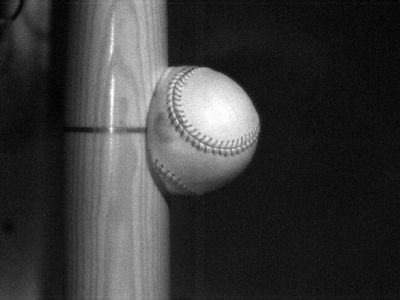Non-conservative force

A force is a critical influence on motion. Some forces visibly change the speed or direction of motion. Other forces convert macroscopic motion to microscopic motion. A non-conservative force is the classification given to any force whose work is dependent on the path taken because microscopic effects are dependent on macroscopic phenomena. In short, a non-conservative force converts macroscopic motion into microscopic motion.
An example of non-conservative forces in a baseball game:
- Normal force: The collision between a baseball and a bat (macroscopic motion) will make a sound (microscopic motion), see Figure 1.
- Air drag: After a baseball player hits the baseball, the ball will move through the air (macroscopic motion). The ball will impart kinetic energy on air molecules and make them vibrate faster. This creates heat (microscopic motion). This is the same as the mechanical equivalent of heat, which converts motion of a fluid to heat. The more air drag there is, the faster the ball will dissipate kinetic energy into thermal energy.
- Friction: When the player slides to the base (macroscopic motion), friction will impart energy into the ground and the player's pants. This causes the atoms in the ground to vibrate more (microscopic motion) and may even cause plastic deformation (like stretching or tearing the pants) that can be further losses of kinetic energy.
All real systems have some non-conservative forces associated with them. For example, when the moon rotates around the Earth it creates tidal forces, which will slightly warm the oceans (microscopic motion of the molecules in the ocean). However, it is a small effect compared to the energy in the system.
By the second law of thermodynamics, all systems lose mechanical energy over time. It is important to note that non-conservative forces do not destroy energy they just convert it into a less useful (less ordered) form.
PhET: Friction force
The University of Colorado has graciously allowed us to use the following PhET simulation. It explores how friction turns macroscopic motion into microscopic.
To learn more about conservative and non-conservative forces, please see hyperphysics.
For Further Reading
- Force
- Conservative force
- Mechanical energy
- Thermal energy
- Tidal force
- Law of conservation of energy
- Or explore a random page
References
- ↑ Picture taken from Baseball: From pitch to hits, by Stephen Ornes. Accessed July 20th, 2018 from: https://www.sciencenewsforstudents.org/article/baseball-pitch-hits

